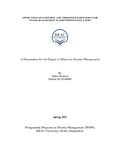Application of scientific and indigenous knowledge for flood management in Northwest Bangladesh
Abstract
The present study tries to identify the Indigenous practices of the rural communities. It also
focuses to assess their economic condition in relation to livelihood practices. Local people
Participation in the research process has ensured by Focus Group Discussion, Informal
Interview. Most of the peoples don’t have any scientific knowledge to coping with flood. The
people of Kurigram district passing their life to cultivated land, Domestic animal, grazing land
and wet land are the major natural resources. The peoples of the rural area face flood & river
bank erosion almost every year. They have some traditional knowledge by which they are able to
cope up with this situation.
In my study I tried to find out the existing indigenous knowledge that has been practice by the
people for anticipating flood and coping mechanism during flood situation. The project looks at
how communities can bring together their own indigenous knowledge and experiences, which
might include birds, insects or plants, in order to support local adaptation to during flood. I also
tried to find out the practices regarding house, agriculture, health. Most of the rural people they
have no academic knowledge but they are living with flood by using their own mechanism for
many years in this area. As a result they have a very good capacity which we called indigenous
knowledge. With this they are able to reduce vulnerabilities. The thesis then identifies why the
region is known for its seasonal food insecurity (Monga) and reason behind the high incidence of
poverty.
This thesis discussed about that both scientific and their own local knowledge is used properly to
inform policy and decision-making at all levels. This thesis emphasizes the integration of
scientific and indigenous knowledge for flood management. Finally I recommended some of my
findings of Kurigram district for further study.

